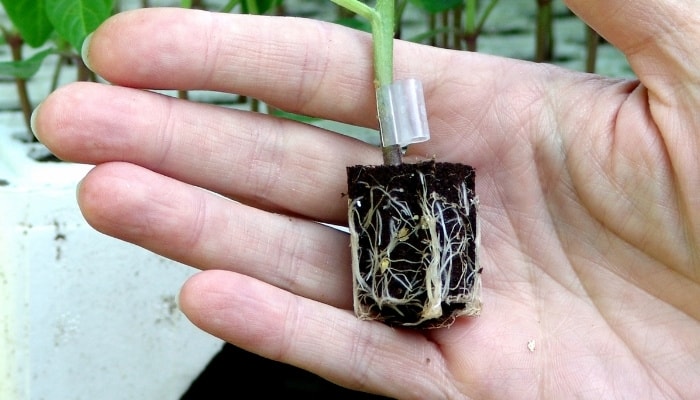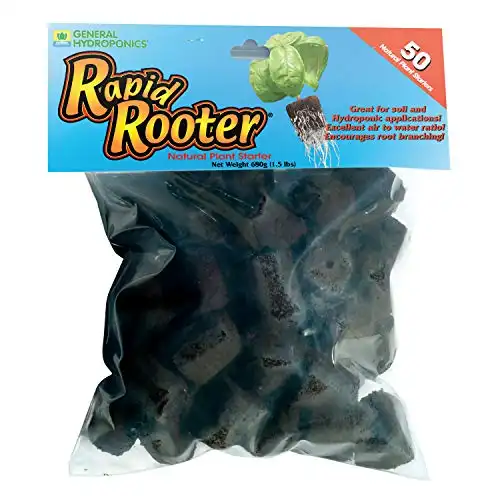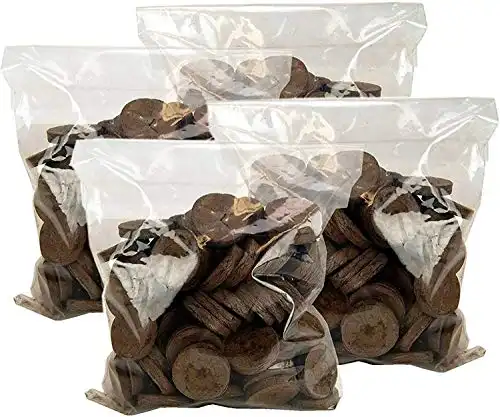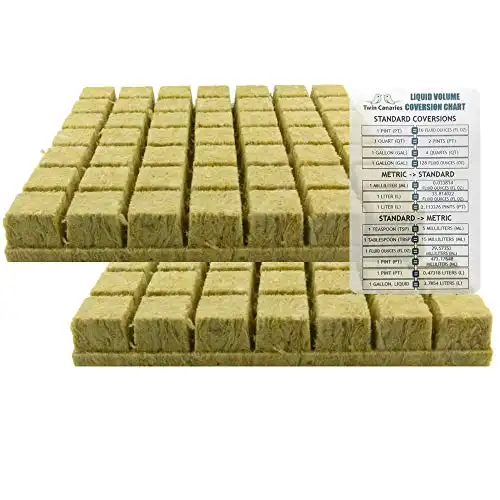In broad terms, two kinds of growing media exist.
One kind is loose, sold by weight. For example, perlite, potting mix, peat moss, and compressed clay pellets, fall into this category (read more about growing media).
The other kind of growing medium comes as individual cubes or cylinders. These are called starter plugs. You may be familiar with popular starter plugs like rockwool, Oasis Horticubes, and, of course, Rapid Rooters.
Rapid Rooter is a type of starter plug made by General Hydroponics, beloved by gardeners and hydroponic growers around the world.
Why Use Starter Plugs?
Starter plugs like rockwool and Rapid Rooters are designed to make your growing process easier.
Instead of mixing your own media and packing it into a seed tray, you can pull a Rapid Rooter right out of the package and put your seed into it.
The chemistry required to make a soil-based or soilless mix is taken out of your hands.
And because starter plugs like Rapid Rooters are compact and don’t break apart easily, they can be used directly in certain hydroponic systems, unlike loose media.
What are Rapid Rooters Made Out Of?
Rapid Rooters are made of Sphagnum peat moss and a binder.
Peat moss is a soilless natural product made of decomposed organic matter, mostly Sphagnum moss.
Peat moss is a favorite medium of gardeners around the world because of its great air-to-water ratio.
It’s highly absorbent without compacting easily.
How Do You Use Rapid Rooters?
Using Rapid Rooters is super simple. You can use these starter plugs to start seeds or to propagate clones.
For those of you who don’t know, cloning is the process of growing seedlings from cuttings of adult plants.
To clone a plant, you can remove a branch, pull off the lower leaves, and stick it into a Rapid Rooter or other starter plug.
From there, it will grow into an exact genetic copy of its “mother” plant.
Whether growing from seed or cuttings, the process is similar and incredibly simple.
Here’s how it’s done:
- Remove a Rapid Rooter from the bag and rehydrate it in water or a diluted nutrient solution. If your Rapid Rooter already feels moist out of the bag, you can skip this step.
- Place your Rapid Rooter(s) into a seed tray.
- Place your seed or cutting into the pre-made hole in the top of the Rapid Rooter.
- Pour about 16 fluid ounces of water into the tray every two to three days, or as needed.
- Place the tray four to six inches under fluorescent or LED lights.
- When roots appear, your Rapid Rooters are ready for transplant into your hydroponic system.
Can Rapid Rooters Be Used In Hydroponics Systems? What Else Are They Good For?
Because Rapid Rooters are a soilless starter plug, they can be used directly in most hydroponic systems.
Once your transplant is ready with lots of visible roots woven through the Rapid Rooter plug, you can pop it into a net pot or any growing media that you will be using, including perlite, expanded clay pellets, and even pure nutrient solution for deep water culture and Kratky setups.
In addition to working great for hydroponics, Rapid Rooters can be used in aeroponics or traditional soil-based gardening or farming.
They work just as well in soil as they do in water.
Do Rapid Rooters Need to Be Used With a Grow Tray?
Yes, Rapid Rooters should be used with a grow tray.
Nothing special is required, just any old tray that will fit the Rapid Rooter will do. If you want, you could even use a plastic cup or another small household container.
The reason for this is simply that these starter plugs won’t stand very well on their own—they need some support.
And, they need to sit in something that can retain water. Once you put your seeds in Rapid Rooters and put them into a tray, they should be watered every few days until the seedling has developed.
Do Rapid Rooters Have Nutrients?
No, Rapid Rooters do not contain any significant amount of nutrients.
They are made of peat moss, a soilless organic material. While peat moss is great for retaining moisture and providing plenty of air to the roots, it won’t give your plant the nutrition it needs.
You can, however, soak your Rapid Rooters in a pH-balanced nutrient solution before using them. This will make for even better seedling growth.
Here’s what I recommend:
- Take a bucket or container large enough to fit all of the Rapid Rooters you will be using.
- Gently place your Rapid Rooters into the container.
- Fill the container with just enough water to cover the Rapid Rooters.
- Add a small amount of nutrient solution to the bucket.
- Add pH-up or pH-down to get to a level that works for the plant you are growing.
- Let the plugs soak in the solution for an hour or up to 24 hours.
- When you are ready to use your Rapid Rooters, just remove them from the liquid, don’t squeeze them, and then add them to your tray.
Can Rapid Rooters Go Bad?
Yes, Rapid Rooters can potentially go bad.
If not stored properly, mold, fungi, or other pathogens can infect the product. In this case, they should be thrown out.
Another common scenario is that you open up a package of Rapid Rooters only to find that they have gone dry. In this case, they are “bad,” but can easily be fixed.
You can either dip them in some water before using them or follow the instructions above on how to hydrate and add nutrients to them simultaneously.
Do Rapid Rooters Have to Be Used For Hydroponics?
No, Rapid Rooters can be used for virtually any kind of gardening or farming.
Rapid Rooters are just peat moss starter plugs. General Hydroponics, the company that makes them, manufactures them in a specific way to keep them moist and compact, but other than that, they are a very simple and versatile growing tool.
Rapid Rooters can be used for germinating seeds, cloning plants, or as a growing medium for hydroponics and aeroponics.
Once you have successfully made a seedling with a Rapid Rooter, it can be transplanted into pretty much anything, be it soil, perlite, nutrient solution, or even more peat moss.
Rapid Rooter vs Rockwool
Rapid Rooters and rockwool are both starter plugs used for seed starting and as a growing medium.
They are very similar, but they get the job done in slightly different ways.
For the most part, they can be used interchangeably. Whichever you use comes down to personal preference.
That being said, here are the differences and pros and cons of Rapid Rooters and rockwool.
Rockwool
- Slightly alkaline pH
- Not biodegradable
- Inexpensive
- Made of rock
- Good water retention
- Viable for seed starting, transplanting, and as a growing medium
Rapid Rooters
- Neutral pH
- Biodegradable
- Expensive
- Made of peat moss
- Contains trace amounts of nutrients, minerals, and beneficial microorganisms
- Can retain too much water if you aren’t careful
- Viable for seed starting, transplanting, and as a growing medium
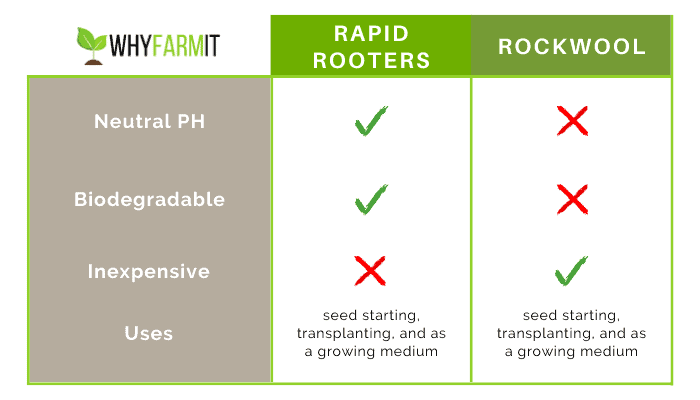
Rapid Rooter Alternatives
Just like rockwool, there are several great alternatives to Rapid Rooters.
These include Root Riot plugs (very similar), Jiffy Pellets, Oasis Horticubes, Pro-Mix, and a variety of soilless mixes.
Each of these can start seeds and act as a growing medium, they just have slightly different features.
Jiffy-7 Pellets
Jiffy pellets are a name-brand starter plug made of peat moss and/or coco coir.
The growing medium is wrapped in a netting and pre-compressed into discs for packaging. You simply add some water to the disk and it grows like an accordion, up to seven times its size, into a normal-sized starter plug.
Jiffy pellets are extremely similar to Rapid Rooters. They both contain peat moss (sometimes coco coir for Jiffy) bound together. The difference is what they are bound with.
Rapid Rooters are held together with some kind of binding foam that is invisible and biodegradable, whereas Jiffy pellets are bound with a plastic netting that isn’t biodegradable.
So, for example, if you were to plant some Jiffy 7 transplants in your garden, those plastic nets would remain in the soil long after your plant was harvested.
This may be less of a concern in hydroponic systems, but from a sustainability standpoint, it is still a factor.
Rockwool
Rockwool is a wool-like starter plug made out of rocks.
Manufacturers melt special rocks and spin them into the fiber to make this product. Rockwool is used across many industries—commonly as insulation or grow media.
The great thing about rockwool is how affordable it is. Compared to some of these name-brand products, rockwool can get the same job done and save you some money.
However, rockwool is not biodegradable and you will need to pH-balance is, as it has a pH of around 8, which is too high for your plants.
Oasis Horticubes
Oasis Horticubes are synthetic foam-like starter plugs. This is a name-brand product, specially engineered for hydroponic seed germination.
The foam doesn’t hold much water but drains incredibly well, making it ideal for constant or drip watering systems, like nutrient film technique (NFT), Dutch buckets, or deep water culture.
Also, the foam doesn’t compress, so even after constant waterings, aeration and drainage will remain the same.
The downside with Oasis Horticubes is that they are more expensive than something like rockwool and are much less versatile.
Because they don’t retain water well, Oasis Horticubes aren’t ideal for hydroponic methods that don’t irrigate frequently, if not, constantly.
Pro-Mix
Pro-Mix is a type of loose, soilless mix.
This isn’t a starter plug, but it can be used similarly. Just take the same tray you would normally use for plugs and fill the cells with Pro-Mix.
Pro-Mix offers a variety of products for different growing applications.
All of the products are peat moss-based and contain beneficial substances to help your seed germinate and grow.
The mix contains biostimulants, which are chemicals or microorganisms that help the plant take in nutrients more efficiently or increase crop quality, as well as mycorrhizae, or beneficial fungi.
While this is a great product, it can be quite expensive and lacks the convenience of preformed starter plugs like Rapid Rooters and rockwool.
Soilless Mixes
Lastly, we have soilless mixes. This is a general term for any loose hydroponic media that may resemble soil but actually contains none (like this one by Fox Farm).
Popular soilless mixes include coco coir, peat moss, perlite, vermiculite, sand, rice hulls, and more.
These growing media can be mixed and combined to provide whatever level of water retention, aeration, and price you desire.
If you care to tweak and refine your own mix, soilless mixes are great as they give you nearly endless customizability.

